Giovanni Battista Cimaroli stands as a significant, albeit sometimes overlooked, figure in the rich tapestry of 18th-century Venetian painting. Active during a period when Venice was a vibrant hub of artistic production and a key destination on the European Grand Tour, Cimaroli carved a distinct niche for himself. While contemporaries like Canaletto captured the dazzling urban spectacle of the city, Cimaroli turned his gaze towards the serene beauty of the surrounding mainland, becoming a celebrated master of the pastoral landscape. His idyllic depictions of the Venetian terraferma, characterized by gentle light, harmonious compositions, and a tranquil atmosphere, found favour with both local patrons and international collectors, securing his place within the Venetian school.
Early Life and Artistic Formation
Giovanni Battista Cimaroli was born in Salò, a town on the shores of Lake Garda near Brescia, in 1687. While the Lombard region had its own artistic traditions, the magnetic pull of Venice, the dominant artistic centre of the region, proved irresistible. In his youth, Cimaroli relocated to Venice to pursue formal artistic training. There, he entered the workshops of painters Antonio Aureggio and Antonio Calza. While less famous today than some of their contemporaries, these masters would have provided Cimaroli with a foundational understanding of technique and composition, likely grounding him in the traditions of landscape and perhaps battle or genre painting, given Calza's specializations.
This early training in Venice placed Cimaroli directly into the bustling artistic environment of the Settecento. He arrived as the city was experiencing a final, brilliant flourishing of its artistic legacy. Painters like Sebastiano Ricci and Giovanni Antonio Pellegrini were already established figures, bringing a lighter, more decorative Rococo sensibility to large-scale history painting. The foundations for the great era of Venetian view painting, or vedute, were being laid by artists such as Luca Carlevaris. It was into this dynamic milieu that Cimaroli would soon establish his own distinct artistic identity.
Establishing a Venetian Career
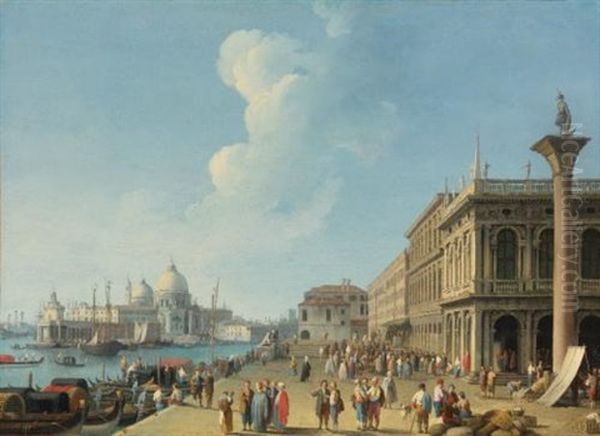
By 1713, Cimaroli had established himself as an independent painter residing in Venice. He quickly specialized in landscape painting, a genre gaining increasing popularity, particularly among foreign visitors undertaking the Grand Tour. These travellers sought souvenirs of their Italian sojourn, and idealized landscapes offered a poetic counterpoint to the precise city views offered by the vedutisti. Cimaroli's focus on the rural environs of Venice – the plains, foothills, villas, and riverbanks of the Veneto – distinguished his work.
His emerging style set him apart. While influenced by the general trend towards lighter palettes and more fluid brushwork characteristic of the Venetian Rococo, Cimaroli developed a personal approach. His landscapes were not strictly topographical representations but rather idealized, almost Arcadian visions of nature. They often featured rolling hills, placid rivers, rustic buildings or classical ruins, and small, elegantly rendered figures – peasants, shepherds, or gentlefolk – seemingly living in peaceful harmony with their surroundings. This emphasis on the idyllic and the serene contrasted with the more dramatic or topographically focused landscapes of some predecessors and contemporaries.
Artistic Style: The Arcadian Vision
Cimaroli's mature style is characterized by a delicate sensibility and a masterful handling of light and atmosphere. His primary influence in the realm of pastoral landscape was Francesco Zuccarelli, a Tuscan painter who spent significant time in Venice and achieved international fame for his charming, idealized Arcadian scenes. Cimaroli absorbed Zuccarelli's penchant for gentle, picturesque compositions, often featuring feathery trees, softly lit skies, and tranquil waters. However, Cimaroli adapted this influence, infusing it with elements perhaps derived from his Lombard roots, resulting in a style that could be both lyrical and grounded.
His brushwork is typically fluid and assured, applied with a lightness of touch that contributes to the overall airy and graceful effect of his paintings. His palette favoured soft, harmonious tones – gentle blues, greens, ochres, and creams – avoiding harsh contrasts and contributing to the peaceful mood. Unlike the sometimes more dramatic or atmospheric landscapes of Marco Ricci, another key figure in Venetian landscape painting, Cimaroli's works often possess a clearer, more tranquil light, bathing the scene in a calm radiance.
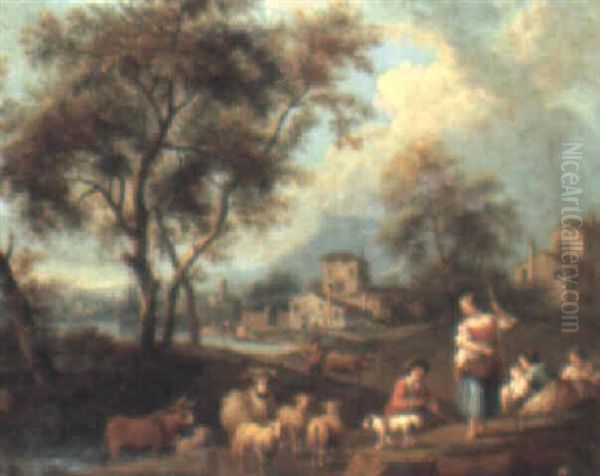
Compositionally, Cimaroli demonstrated skill in creating balanced and inviting scenes. He often employed receding planes to establish a sense of depth, leading the viewer's eye through the landscape towards distant hills or a luminous horizon. His unique interpretation of undulating terrain became a hallmark of his work. While idealized, his landscapes often incorporated specific details – rustic farmhouses, villas, ancient ruins – that added a layer of visual interest and specificity, preventing them from becoming purely generic Arcadian fantasies. Some critics noted a particular "dry and sharp" quality in his execution at times, suggesting a precision that complemented the overall softness.
Collaboration and the McSwiny Commission
One of the most fascinating episodes in Cimaroli's career involved his participation in a unique collaborative project orchestrated by the Irish impresario Owen McSwiny (or Swiny). McSwiny, acting as an agent for the British nobleman Charles Lennox, the 2nd Duke of Richmond, conceived a series of large allegorical paintings intended to commemorate illustrious figures from recent British history – statesmen, scientists, military leaders, and intellectuals like Sir Isaac Newton. The unusual aspect was that these were imagined funerary monuments set within elaborate landscape or architectural settings.
Around 1726, McSwiny commissioned several prominent Venetian artists to work together on these canvases, a practice not uncommon in Venice at the time. Cimaroli was brought into this prestigious group, which included the leading lights of the Venetian school: Giovanni Battista Canal, better known as Canaletto, Giovanni Battista Piazzetta, and Giovanni Battista Pittoni. Donato Creti and Sebastiano Ricci were also involved in the broader project. In these collaborations, specific artists were often assigned parts of the painting according to their specialities. Piazzetta and Pittoni typically handled the main figures, while Canaletto might contribute architectural elements or specific views. Cimaroli's designated role was crucial: he provided the landscape settings for several of the allegorical tombs.
His contribution to the Allegorical Tombs series highlights his standing among the elite Venetian painters of his day. To be chosen alongside Canaletto and Piazzetta for such a high-profile commission, destined for an important British aristocratic collection, speaks volumes about his reputation. His ability to create evocative, suitable landscape backgrounds that complemented the allegorical figures and grand architectural elements was clearly highly valued. These works, now dispersed but partially held in collections like the National Gallery, London, remain a testament to this remarkable collaborative venture.
Patronage and International Appeal
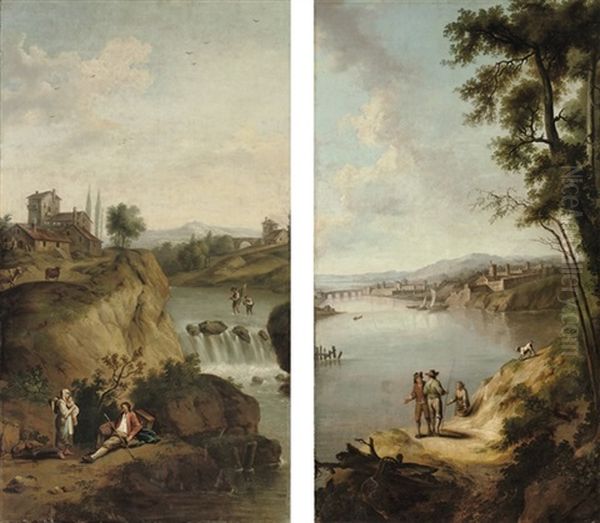
Cimaroli enjoyed considerable success during his lifetime, attracting a distinguished clientele. His patrons included members of the Venetian nobility who appreciated his refined depictions of the local countryside. Furthermore, his work found favour with prominent collectors residing in Venice, such as the renowned Field Marshal Johann Matthias von der Schulenburg, a German mercenary commander whose vast art collection included works by many leading Venetian artists. The collection of Countess Tessin also featured his paintings.
Crucially, Cimaroli's art appealed strongly to the burgeoning market created by foreign visitors, particularly the British undertaking the Grand Tour. His idealized landscapes offered a poetic vision of Italy that resonated with the tastes of these travellers. The aforementioned McSwiny commission is one example of this British connection. Another vital link was Joseph Smith, the British Consul in Venice from 1744 to 1760. Smith was a major patron and art dealer, most famously associated with Canaletto, but he also acquired and promoted the works of other Venetian artists, including Cimaroli. Through figures like Smith, Cimaroli's paintings found their way into important British collections, contributing to his international reputation.
The demand for his work reflects a broader European fascination with Italian landscape painting in the 18th century. Cimaroli's particular blend of idealized nature, gentle light, and elegant detail perfectly suited the Rococo aesthetic prevalent across much of Europe. His success demonstrates how Venetian artists catered not only to local tastes but also to a sophisticated international market eager for images of Italy's famed beauty.
Relationship with Contemporaries
Cimaroli operated within a vibrant and competitive artistic scene in Venice. His relationship with Canaletto is particularly noteworthy. While they collaborated on the McSwiny project, they were also, in a sense, competitors catering to overlapping markets, especially among foreign patrons. However, their primary outputs differed significantly. Canaletto became the preeminent painter of vedute, detailed and often topographically accurate views of Venice itself. Cimaroli, conversely, focused on the campagna, the countryside, offering idealized pastoral scenes rather than precise urban documentation. This distinction allowed both artists to flourish.
His style shows a clear debt to Francesco Zuccarelli, who popularized the Arcadian landscape in Venice. Cimaroli built upon Zuccarelli's model, perhaps adding a slightly more realistic touch derived from Lombard traditions or the influence of earlier Venetian landscape painters like Marco Ricci. Ricci, along with his uncle Sebastiano Ricci, had been instrumental in developing landscape as an independent genre in Venice, often favouring more dramatic compositions and atmospheric effects than Cimaroli typically employed.
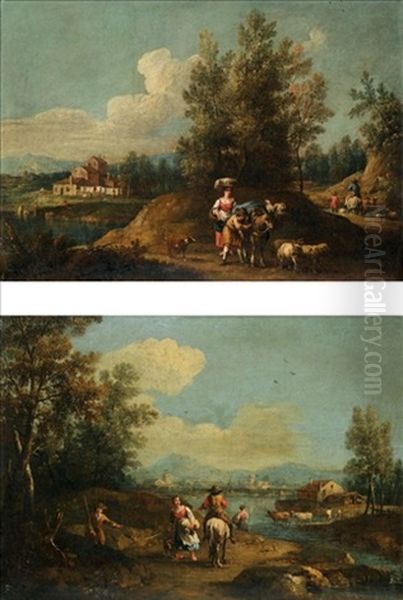
Cimaroli was also aware of the work of Luca Carlevaris, an earlier Venetian painter known for his detailed depictions of Venetian festivals and ceremonies, often set within recognizable city locations but also demonstrating a sensitivity to landscape elements. While Carlevaris's focus was different, his meticulous approach to detail might have resonated with Cimaroli. Other contemporaries whose work formed the backdrop to Cimaroli's career include the great decorative painter Giovanni Battista Tiepolo, the celebrated pastellist Rosalba Carriera, and later veduta painters like Francesco Guardi and Michele Marieschi (whose work, along with that of his father Jacopo Marieschi, was sometimes confused with Cimaroli's, requiring later scholarly clarification).
Representative Works
While a comprehensive catalogue of Cimaroli's work has been a subject of relatively recent scholarship, several paintings exemplify his style and subject matter.
The Molo, Venice, looking West: Although primarily a landscape painter, Cimaroli did occasionally depict Venetian scenes. A notable example, identified as his work and housed in the Bendigo Art Gallery, Australia, shows the busy Molo, the quay in front of the Doge's Palace and Piazzetta. While Canaletto might have focused on architectural precision, Cimaroli's version likely emphasizes the bustling activity and atmospheric light, distinguishing it from the work of pure vedutisti like Canaletto or the Marieschi family.
Piazza San Marco during the 'Caccia dei Tori': Attributed works depicting festivals or events in Venice, such as a bull-chasing event in Piazza San Marco (potentially related to a visit by Duke Friedrich Christian of Saxony-Poland, though the exact title varies), show his ability to handle complex scenes with numerous figures within an urban setting, possibly collaborating or competing with artists like Canaletto who frequently depicted such events. A version related to this theme is in the National Gallery, London.
Peasants and Farmers by a River: This title represents a common theme in Cimaroli's oeuvre. Paintings like this, often featuring serene river landscapes populated by rustic figures engaged in daily activities or repose, showcase his mastery of the pastoral genre. These works emphasize the harmony between humanity and nature, rendered in his characteristic soft palette and fluid style. An example with this title, measuring 70x92 cm, highlights his typical easel-painting format.
The Allegorical Tombs (McSwiny Commission): As discussed, his contributions to this series are significant. While the figures and primary allegorical elements were by collaborators like Piazzetta or Pittoni, Cimaroli provided the essential landscape contexts – rolling hills, classical ruins, atmospheric skies – that framed these imagined monuments. His landscapes were integral to the overall effect of these complex compositions.
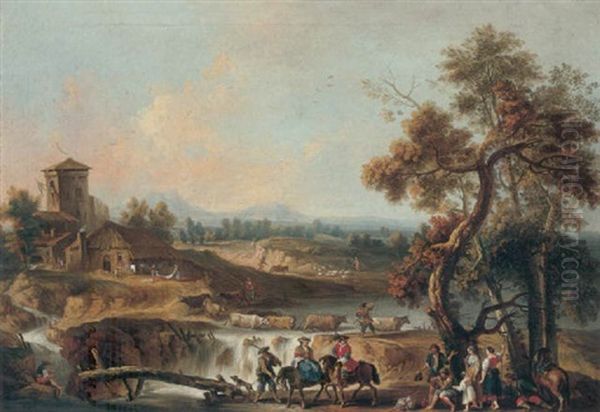
Italian Landscape with Figures and Ruins: Many of his works fall under general titles like this. They typically feature idealized Italian scenery, often incorporating classical ruins to evoke a sense of history and Arcadian nostalgia, alongside elegantly drawn figures that animate the scene. These paintings perfectly capture the picturesque sensibility favoured by Grand Tour collectors.
These examples illustrate the range of Cimaroli's work, centred on the pastoral landscape but also encompassing occasional Venetian views and significant collaborative projects. His consistent style – characterized by gentle light, harmonious composition, and idealized nature – is evident across his output.
Later Career and Legacy
Giovanni Battista Cimaroli continued to paint actively throughout the first half of the 18th century, maintaining his reputation as one of the leading landscape painters in Northern Italy. His works were sought after, and he seems to have enjoyed sustained success until his death in Venice in 1753. His paintings circulated widely, not only in Venice and Britain but likely elsewhere in Europe, reflecting the broad appeal of his gentle, picturesque style.
Despite his contemporary success, Cimaroli's fame waned significantly after his death. During the 19th and early 20th centuries, art historical attention focused more intensely on the grand history painters like Tiepolo or the iconic vedutisti like Canaletto and Guardi. Landscape painters, particularly those specializing in the idealized pastoral genre like Cimaroli and Zuccarelli, were often relatively neglected. His name became less familiar, and his works were sometimes misattributed.
Rediscovery and Modern Appreciation
It was not until the mid-20th century and beyond that dedicated art historical scholarship began to re-evaluate Giovanni Battista Cimaroli's contribution. Careful study, the identification of signed or documented works, and comparative stylistic analysis allowed experts to reconstruct his oeuvre more accurately and distinguish his hand from those of his contemporaries, including Canaletto, Zuccarelli, Marco Ricci, and the Marieschi family. The publication of catalogues and scholarly articles dedicated to his work has been crucial in restoring his reputation.
Today, Cimaroli is recognized as a distinct and talented voice within the Venetian Settecento. His paintings are appreciated for their technical skill, their charming aesthetic, and their embodiment of the 18th-century taste for the pastoral ideal. His works are held in numerous public museums and private collections around the world, including the National Gallery in London, the Royal Collection Trust, the Gallerie dell'Accademia in Venice, the Bendigo Art Gallery, and many others. Auction results and museum exhibitions demonstrate a renewed appreciation for his gentle, evocative landscapes.
Influence and Conclusion
Giovanni Battista Cimaroli's influence extended primarily through the continuation of the pastoral landscape tradition. While perhaps not as dramatically innovative as some of his contemporaries, his refined style and successful career contributed to the popularity and development of landscape painting in 18th-century Venice and beyond. Artists like Pasquale Pecho are noted as having been influenced by his approach. More broadly, his work represents a significant facet of the Venetian Rococo, showcasing the era's taste for elegance, grace, and idealized nature.
In conclusion, Giovanni Battista Cimaroli was a highly skilled and successful painter who made a significant contribution to 18th-century Venetian art. Born near Brescia but flourishing in Venice, he specialized in idealized pastoral landscapes that captured the serene beauty of the Venetian mainland. Influenced by masters like Francesco Zuccarelli but developing his own distinct style characterized by soft light, fluid brushwork, and harmonious compositions, he found favour with both local and international patrons. His collaboration with leading artists like Canaletto, Piazzetta, and Pittoni on the McSwiny commission attests to his high standing. Though somewhat overshadowed in later centuries, modern scholarship has rightfully restored Cimaroli's reputation as a master of the Venetian landscape, whose charming and tranquil visions continue to delight viewers today.